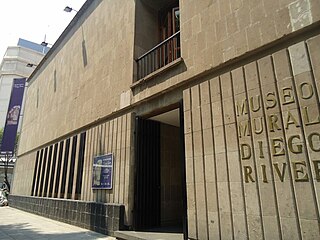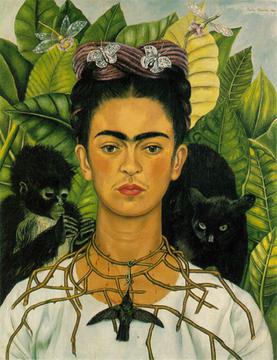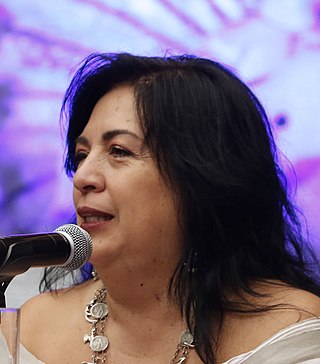
Diego Rivera was a prominent Mexican painter. His large frescoes helped establish the mural movement in Mexican and international art.

Magdalena Carmen Frida Kahlo y Calderón was a Mexican painter known for her many portraits, self-portraits, and works inspired by the nature and artifacts of Mexico. Inspired by the country's popular culture, she employed a naïve folk art style to explore questions of identity, postcolonialism, gender, class, and race in Mexican society. Her paintings often had strong autobiographical elements and mixed realism with fantasy. In addition to belonging to the post-revolutionary Mexicayotl movement, which sought to define a Mexican identity, Kahlo has been described as a surrealist or magical realist. She is also known for painting about her experience of chronic pain.

Frida is a 2002 American biographical drama film directed by Julie Taymor which depicts the professional and private life of the surrealist Mexican artist Frida Kahlo.

Arturo García Bustos was a Mexican painter and print maker. He is known as one of “Los Fridos” students who studied under Frida Kahlo at her home in Coyoacán.

Lola Álvarez Bravo was the first Mexican female photographer and a key figure in the post-revolution Mexican renaissance. Known for her high level of skill in composition, her works were seen by her peers as fine art. She was recognized in 1964 with the Premio José Clemente Orozco, by the State of Jalisco, for her contributions to photography and her efforts to preserve the culture of Mexico. Her works are included in the permanent collections of international museums, including the Museum of Modern Art in New York City.

The Diego Rivera Anahuacalli Museum is a museum and arts center in Mexico City, located in the San Pablo de Tepetlapa neighborhood of Coyoacán, 10 minutes by car from the Frida Kahlo Museum, as well as from the tourist neighborhood of this district.

The Museo de Arte Moderno (MAM) is a museum dedicated to modern Mexican art located in Chapultepec Park in Mexico City.

María de los Dolores Olmedo y Patiño Suarez was a Mexican businesswoman, philanthropist and musician, better known for her friendship with the Mexican painters Frida Kahlo and her husband Diego Rivera; she appeared in some of his paintings. Following Rivera's death in 1957, she and Rivera's daughter Guadalupe asked then president Adolfo López Mateos to consider Rivera and José Clemente Orozco's paintings historical monuments.
Fanny Rabel, born Fanny Rabinovich, was a Polish-born Mexican artist who is considered to be the first modern female muralist and one of the youngest associated with the Mexican muralism of the early to mid 20th century. She and her family arrived to Mexico in 1938 from Europe and she studied art at the Escuela Nacional de Pintura, Escultura y Grabado "La Esmeralda", where she met and became friends with Frida Kahlo. She became the only female member of “Los Fridos” a group of students under Kahlo’s tutelage. She also worked as an assistant and apprentice to Diego Rivera and David Alfaro Siqueiros, painting a number of murals of her own during her career. The most significant of these is "Ronda en el tiempo" at the Museo Nacional de Antropología in Mexico City. She also created canvases and other works, with children often featured in her work, and was one of the first of her generation to work with ecological themes in a series of works begun in 1979.

Alice Phillipot (Alice Rahon) (8 June 1904 – September 1987) was a French-born Mexican poet and artist whose work contributed to the beginning of abstract expression in Mexico. She began as a surrealist poet in Europe but began painting in Mexico. She was a prolific artist from the late 1940s to the 1960s, exhibiting frequently in Mexico and the United States, with a wide circle of friends in these two countries. Her work remained tied to surrealism but was also innovative, including abstract elements and the use of techniques such as sgraffito and the use of sand for texture. She became isolated in her later life due to health issues.

Angelina Beloff was a Russian-born artist who did most of her work in Mexico. However, she is better known as Diego Rivera’s first wife, and her work has been overshadowed by his and that of his later wives. She studied art in Saint Petersburg and then went to begin her art career in Paris in 1909. This same year she met Rivera and married him. In 1921, Rivera returned to Mexico, leaving Beloff behind and divorcing her. She never remarried. In 1932, through her contacts with various Mexican artists, she was sponsored to live and work in the country. She worked as an art teacher, a marionette show creator and had a number of exhibits of her work in the 1950s. Most of her work was done in Mexico, using Mexican imagery, but her artistic style remained European. In 1978, writer Elena Poniatowska wrote a novel based on her life.

The Frida Kahlo Museum, also known as the Blue House for the structure's cobalt-blue walls, is a historic house museum and art museum dedicated to the life and work of Mexican artist Frida Kahlo. It is located in the Colonia del Carmen neighborhood of Coyoacán in Mexico City. The building was Kahlo's birthplace, the home where she grew up, lived with her husband Diego Rivera for a number of years, and where she later died in a room on the upper floor. In 1957, Diego Rivera donated the home and its contents to turn it into a museum in Frida's honor.

Ana Karen Allende is a Mexican artisan from the Mexico City borough of Coyoacán, who specializes in creating rag dolls and soft fabric animals. The tradition of making rag dolls in Mexico extends back to the pre-Hispanic period with the making of rag dolls reaching its peak in the 19th century. Allende's first doll was made when her sister was about to turn fifteen. For quinceañera celebrations in Xochimilco, it is customary to give the girl her “last doll” as a means of marking her transition from child to adult. Allende decided to make this doll herself, using sewing skills taught to her by her grandmother. Soon after, she began to make dolls for her friends and family, and the attention they received prompted her to think of selling them.

Museo Mural Diego Rivera is a museum in Mexico City where Diego Rivera's 1946–47 mural Sueño de una Tarde Dominical en la Alameda Central is located.

The Two Fridas is an oil painting by Mexican artist Frida Kahlo. The painting was the first large-scale work done by Kahlo and is considered one of her most notable paintings. It is a double self-portrait, depicting two versions of Kahlo seated together. One is wearing a white European-style Victorian dress, while the other is wearing a traditional Tehuana dress. The painting is housed at the Museo de Arte Moderno in Mexico City.

Self-Portrait with Thorn Necklace and Hummingbird is a 1940 self-portrait by Mexican painter Frida Kahlo which also includes a black cat, a monkey, and two dragonflies. It was painted after Kahlo's divorce from Diego Rivera and the end of her affair with photographer Nickolas Muray.

Betsabeé Romero is a Mexican visual artist. Her works include sculptures, installations, printmaking, perforated paper, photographs, and videos. She has exhibited widely, and has been featured in more than forty one-person exhibitions in the Americas, Africa, Asia and Europe.
The Rivals is a 1931 oil-on-canvas painting by the Mexican artist Diego Rivera (1886–1957). It was commissioned by Abby Aldrich Rockefeller, the leading personage behind the inception of the Museum of Modern Art in New York City. Rivera created the work while on the ship SS Moro en route from Mexico to New York City. The picture portrays "Las Velas", a festival held in the Mexican state of Oaxaca, a fete in honor of local patron saints and of the abundance of spring.
























